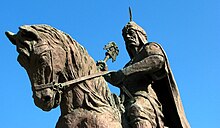Kayqubad I
| Kayqubad I | |||||
|---|---|---|---|---|---|

Statue of Kaykubad I in Alanya
|
|||||
| Seljuq sultans of Rum | |||||
| Reign | 1220–1237 | ||||
| Predecessor | Kaykaus I | ||||
| Successor | Kaykhusraw II | ||||
| Born | 1188 | ||||
| Died | 1237 | ||||
| Consort | Mahpari Hunat Khatun Adila Ghaziya Khatun Ismat al-dunya wa'l-din |
||||
|
|||||
| House | House of Seljuq | ||||
| Father | Kaykhusraw I | ||||
| Full name | |
|---|---|
| Alā ad-Dīn Kayqubād bin Kaykāvūs |
Kayqubad I or Alā ad-Dīn Kayqubād bin Kaykāvūs (Persian: علاء الدين كيقباد بن كيكاوس; Turkish: I. Alâeddin Keykûbad, 1188–1237) was the Seljuq Sultan of Rûm who reigned from 1220 to 1237. He expanded the borders of the sultanate at the expense of his neighbors, particularly the Mengujek Beylik and the Ayyubids, and established a Seljuq presence on the Mediterranean with his acquisition of the port of Kalon Oros, later renamed Ala'iyya in his honor. He also brought the southern Crimea under Turkish control for a brief period as a result of a raid against the Black Sea port of Sudak. The sultan, sometimes styled "Kayqubad the Great", is remembered today for his rich architectural legacy and the brilliant court culture that flourished under his reign.
Kayqubad's reign represented the apogee of Seljuq power and influence in Anatolia, and Kayqubad himself was considered the most illustrious prince of the dynasty. In the period following the mid-13th century Mongol invasion, inhabitants of Anatolia frequently looked back on his reign as a golden age, while the new rulers of the Anatolian beyliks sought to justify their own authority through pedigrees traced to him.
Kayqubad was the second son of Sultan Kaykhusraw I, who bestowed upon him at an early age the title malik and the governorship of the important central Anatolian town of Tokat. When the sultan died following the battle of Alaşehir in 1211, both Kayqubad and his elder brother Kaykaus struggled for the throne. Kayqubad initially garnered some allies among the neighbors of the sultanate: Leo I, the king of Cilician Armenia and Tughrilshah, the brothers' uncle and the independent ruler of Erzurum. Most of the emirs, as the powerful landed aristocracy of the sultanate, supported Kaykaus. Kayqubad was forced to flee to the fortress at Ankara, where he sought aid from the Turkman tribes of Kastamonu. He was soon apprehended and imprisoned by his brother in a fortress in western Anatolia.
...
Wikipedia
